Egison Presentation for Rakuten Technology Conference 2015
In RTC 2015, Matz and I gave a presentation on the thought behind the creation of programming languages together! The following slides and script are my part. We can see the video of our session on YouTube.
#1
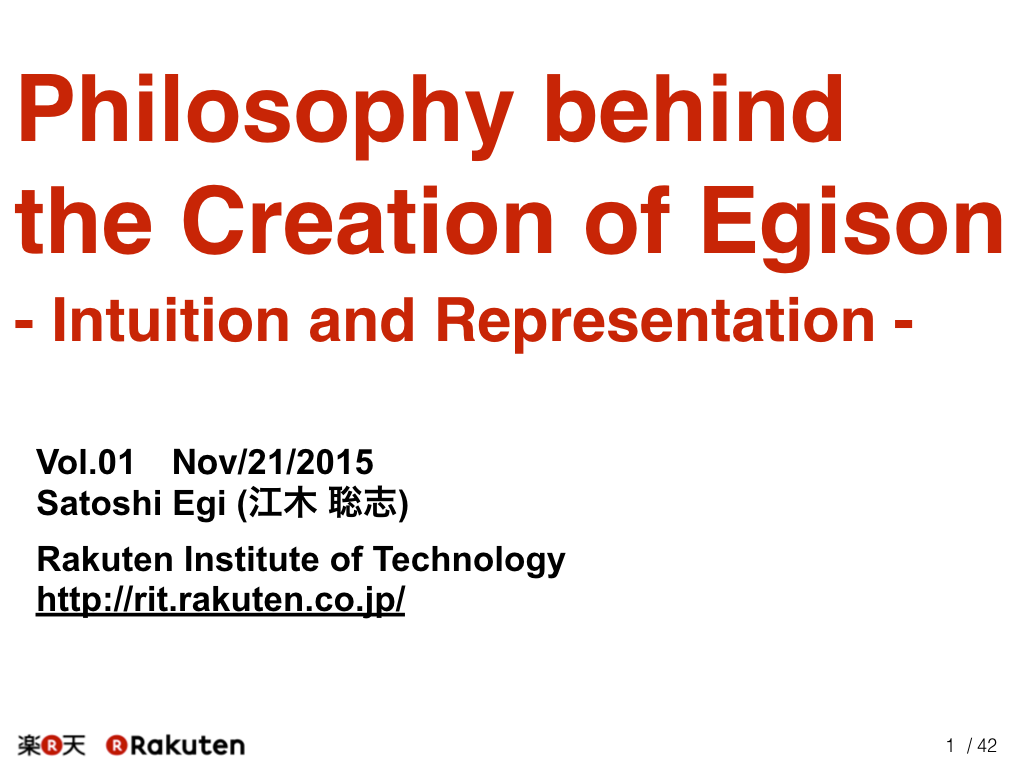
Today, I’ll make a presentation on the thought behind the creation of Egison. Here is the slides and script for that.
#2
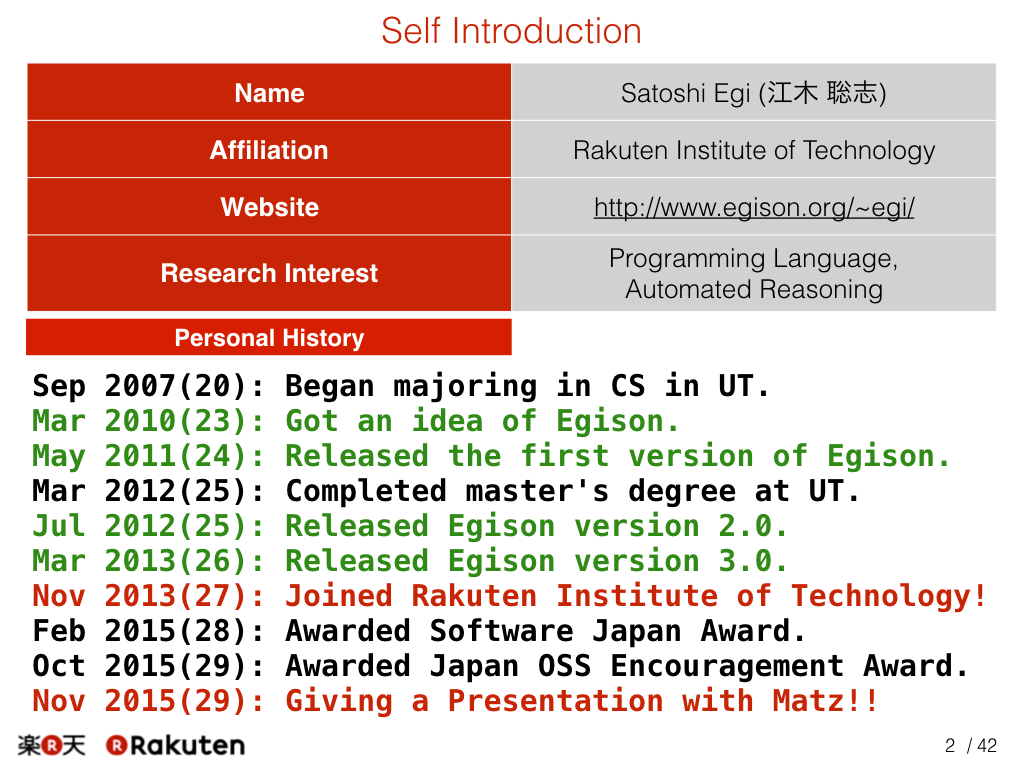
At first, let me introduce myself. I am a researcher working for Rakuten Institute of Technology. My research interest includes programming language theory. Here is my brief personal history. I released the Egison programming language in 2011 when I was a student of the university of Tokyo. I have continued the development of Egison even after I graduated the university in 2012. And I joined Rakuten in 2013. After that, Egison is gradually getting popular and recently I have received several awards for creating Egison. And today, I am giving a presentation with Matz!
#3
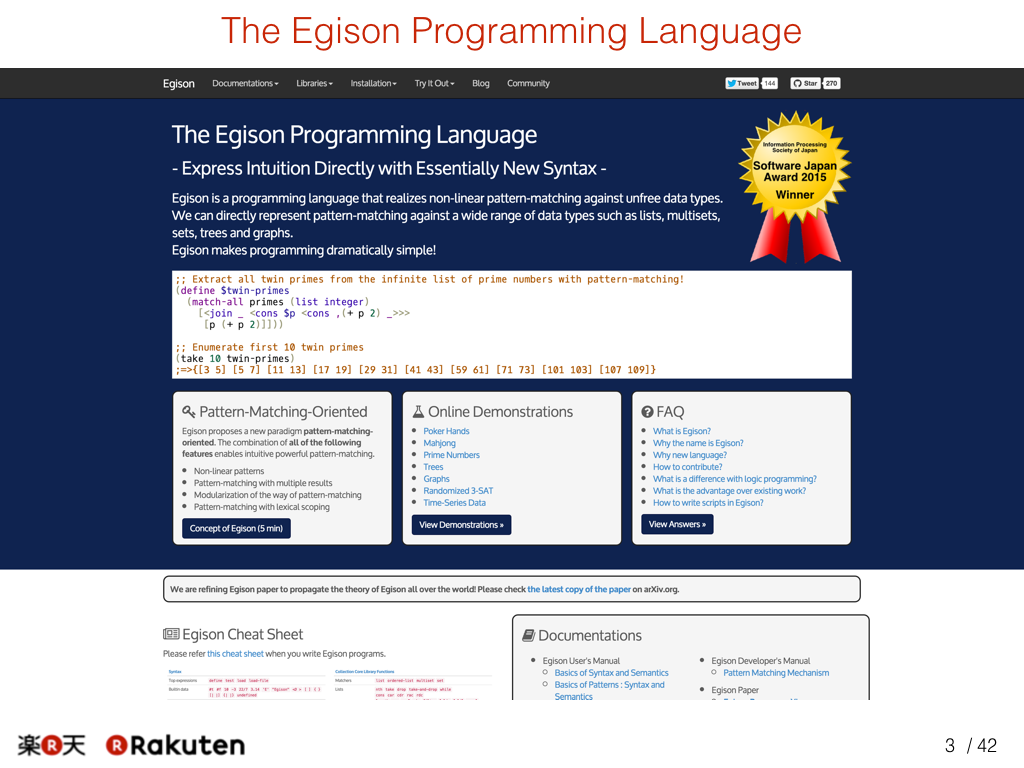
Egison has been released as open source software and has its website. Please visit it when you have time.
#4
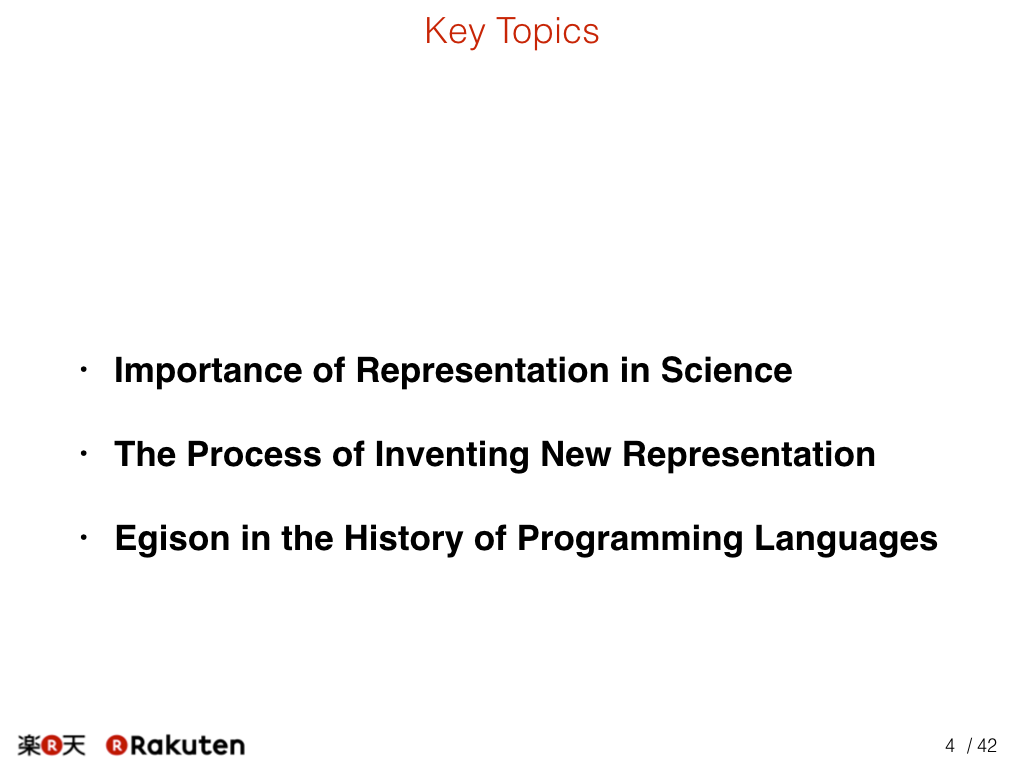
Today, I’d like to talk 3 things. First, the importance of representation in Science, a reason why I am researching on programming languages. Second, the process of inventing new representation. Finally, I’ll introduce Egison and talk how Egison invented.
#5
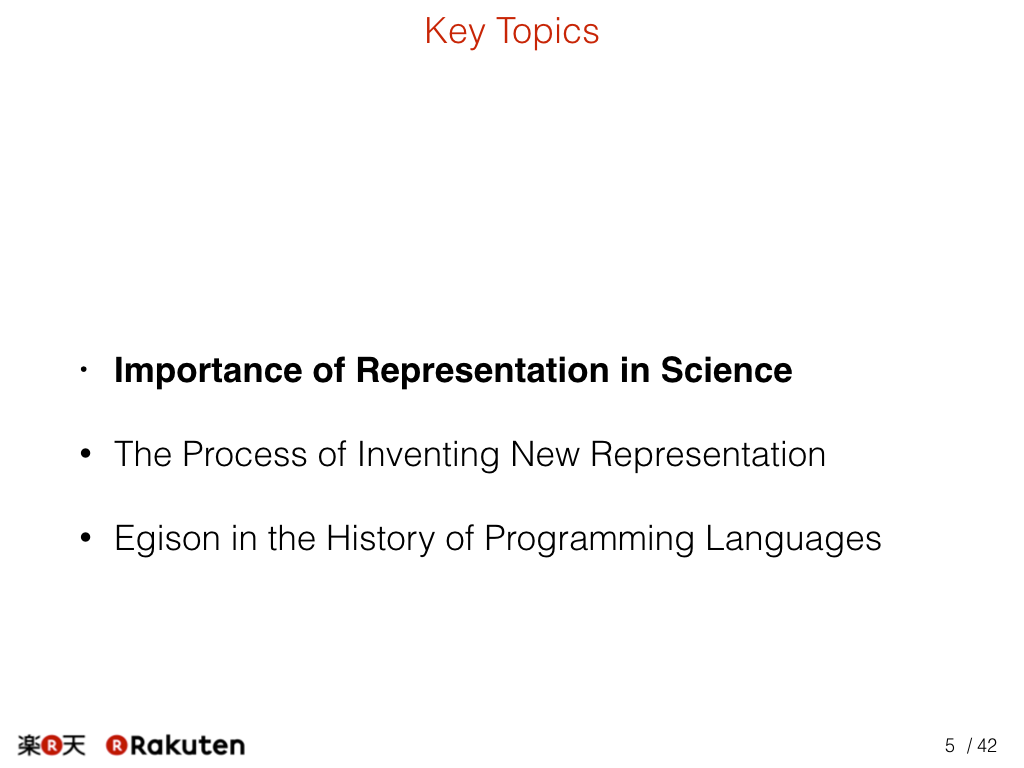
At first, let me talk about the importance of Representation in Science.
#6
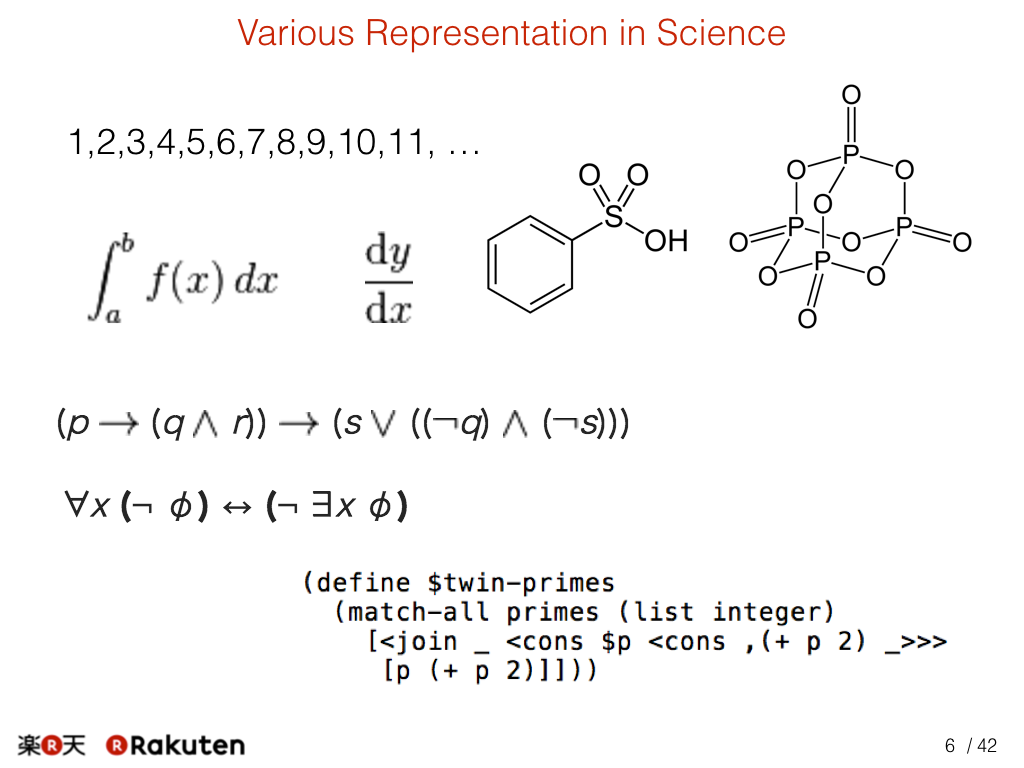
There are a lot of representation. Here are examples from number notation, mathematical expressions, chemical formulas and programming languages. Humans have invented various representation up to the present.
#7
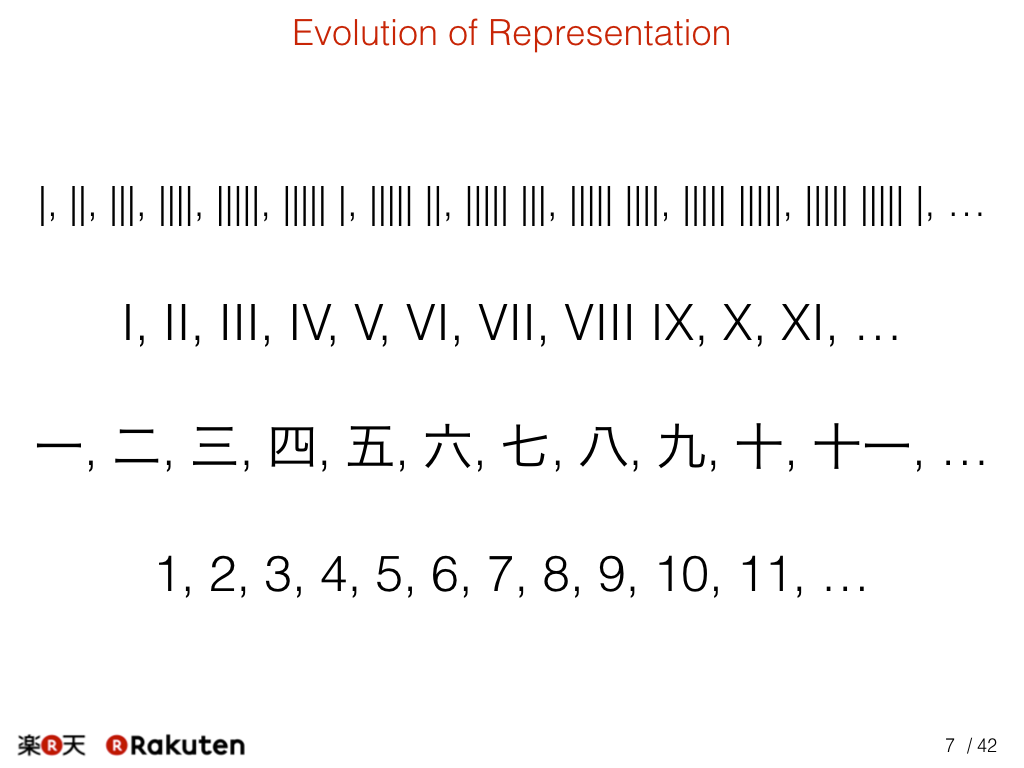
The representation has been developed over a long time. Various number notations are developed in each cultural region. Roman numerals, Chinese numerals, and Hindu-Arabic numerals are in this list.
#8
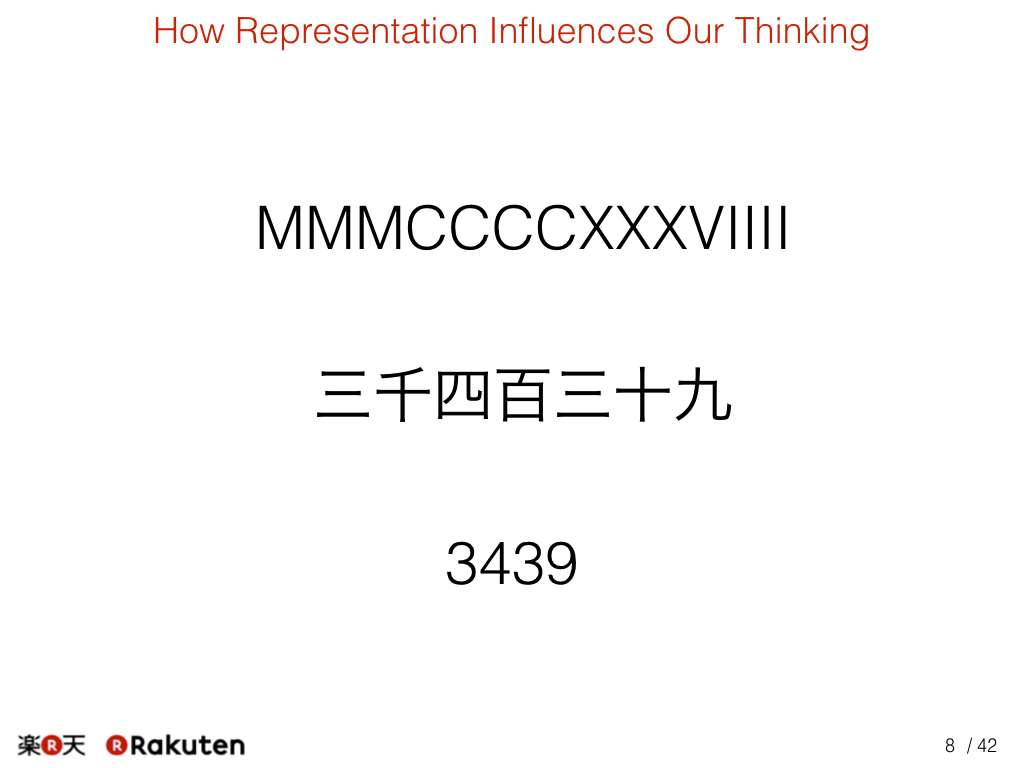
There are distinct differences among readability of these numerals.
This difference is not only because we are accustomed to Hindu-Arabic numerals. It arises from the mathematical features that each numeral based on.
#9
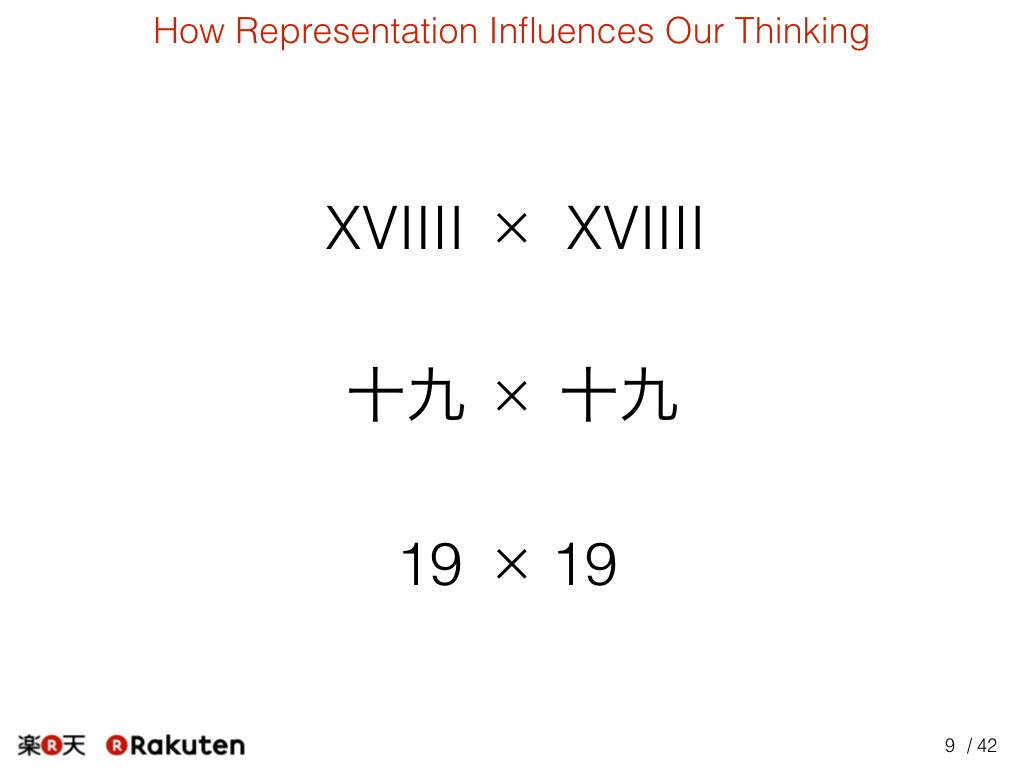
Let me explain this difference further. The difference become bigger when we calculate using them. It’s harder to calculate multiplication using Roman numerals and Chinese numerals than Hindu-Arabic numerals.
#10
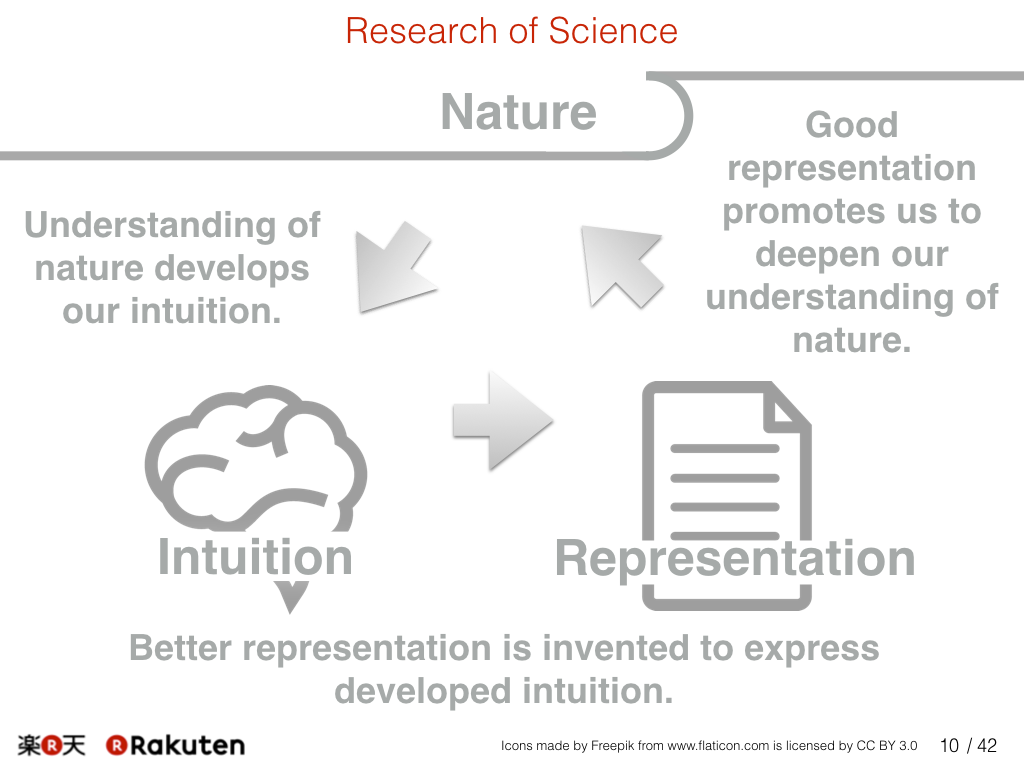
This is a diagram to show the role of representation in the research of science.
#11
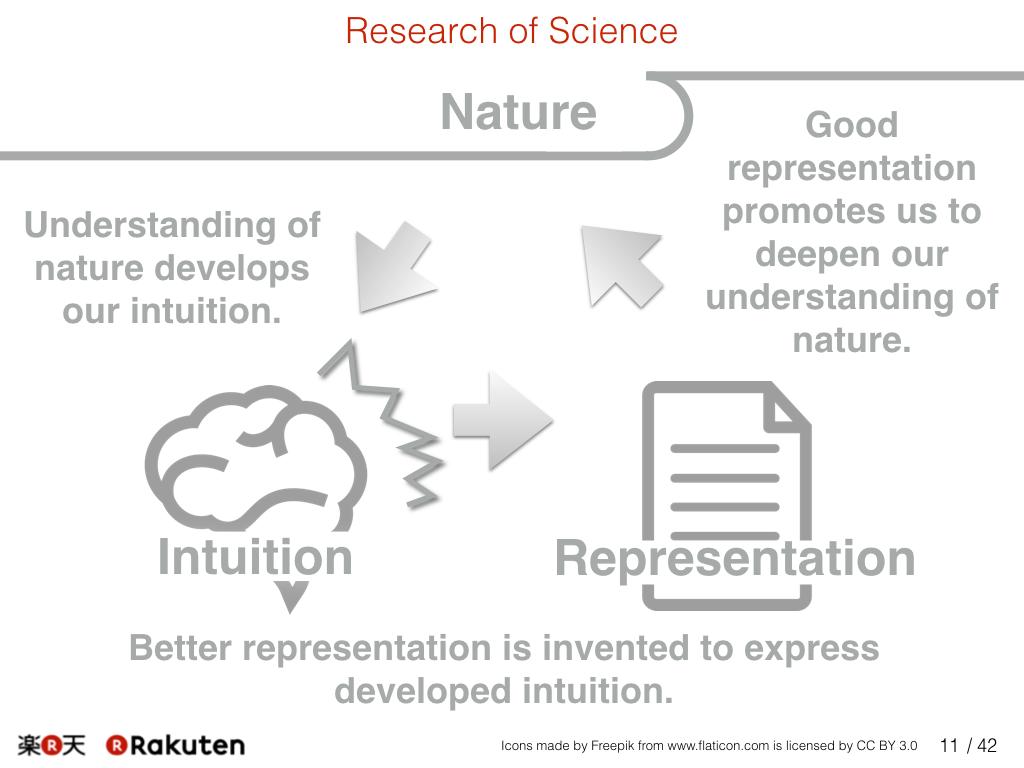
First we observe nature, and it develops our intuition.
#12
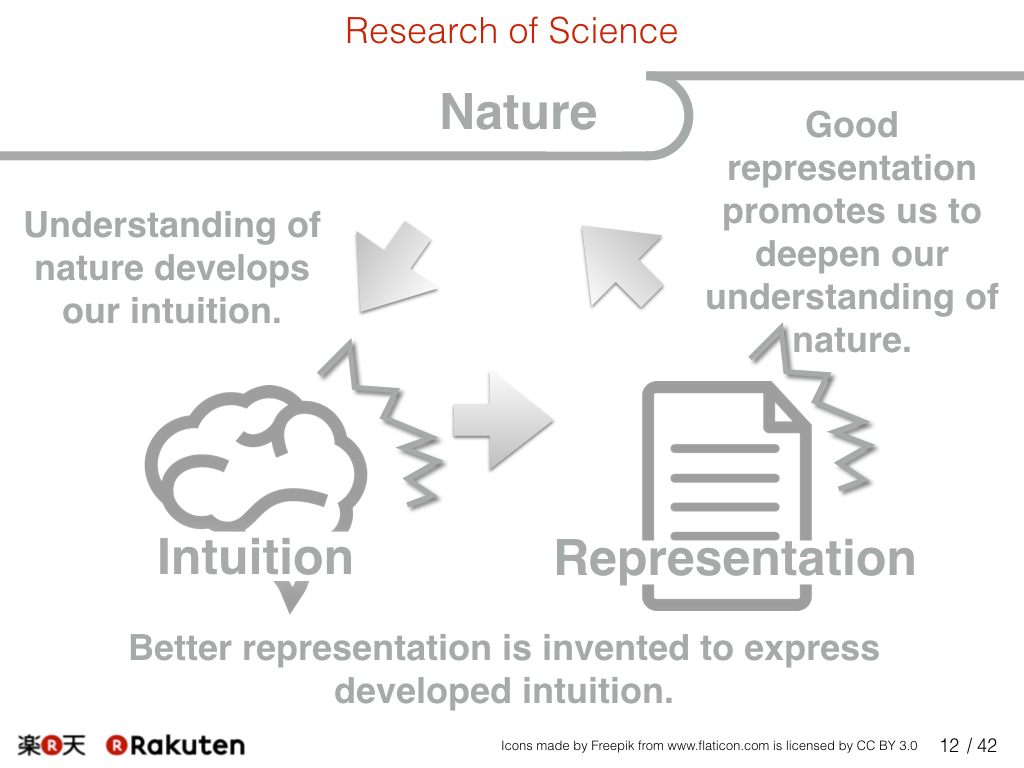
This process helps us to develop better understanding which lead to a better representation.
#13
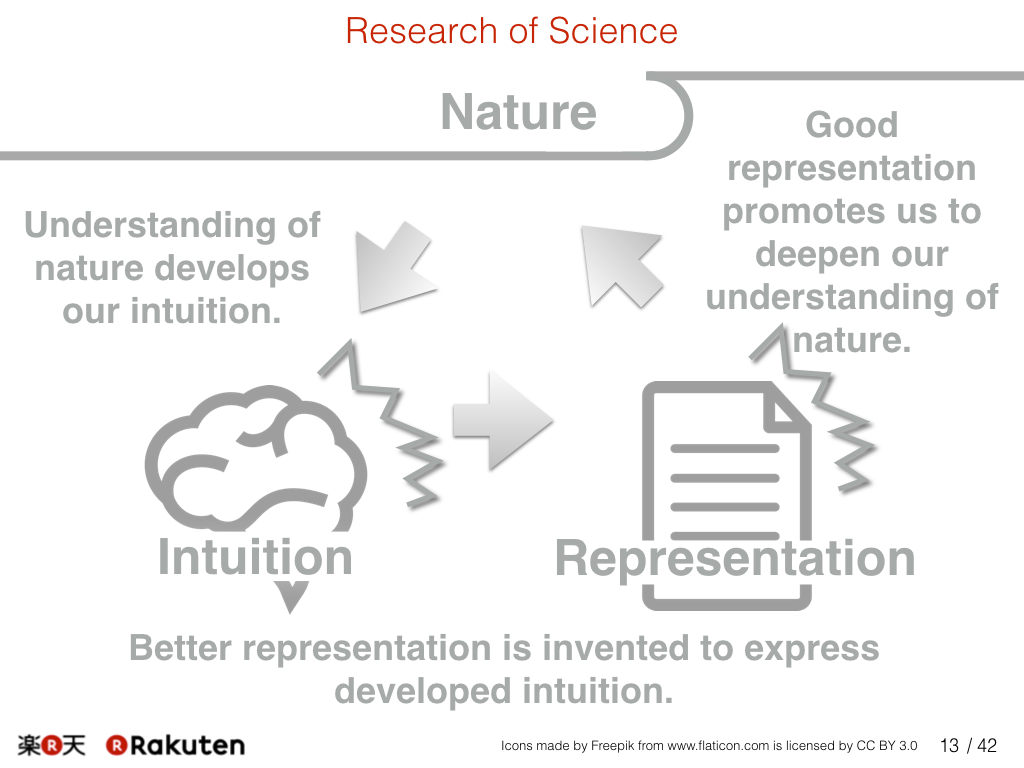
Good representation helps us to deepen our understanding of nature. For example, in the middle ages, after Hindu-Arabic numerals were introduced in Europe, European mathematics developed significantly.
Representation plays really important role in research of Science.
#14
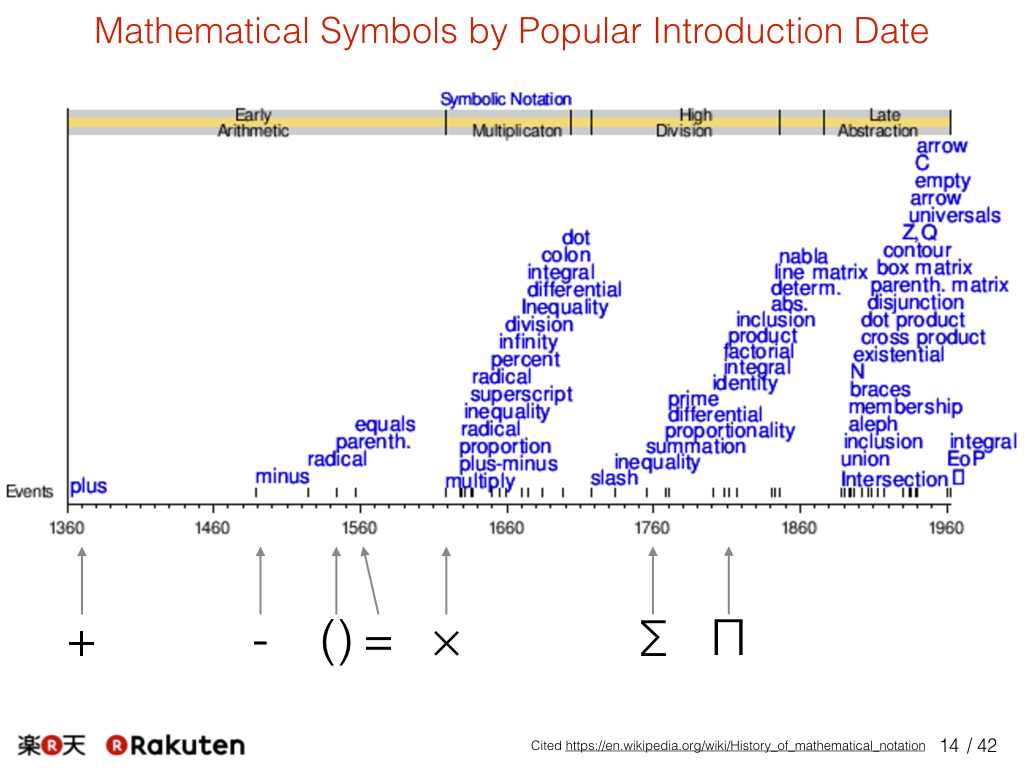
We can see that in the history of mathematical symbols. The mathematical symbols such as plus and minus are invented in the middle ages. After that, mathematics developed quickly and at the same time the number of symbols also increased significantly.
#15
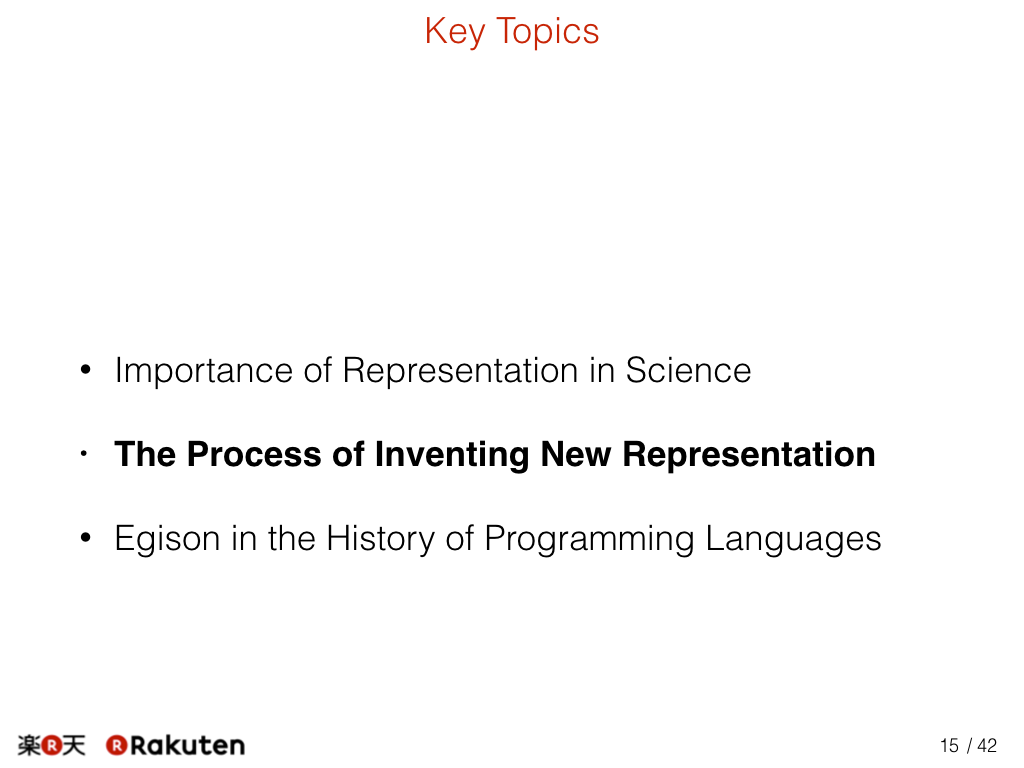
Next topic is the process of inventing new representation.
#16
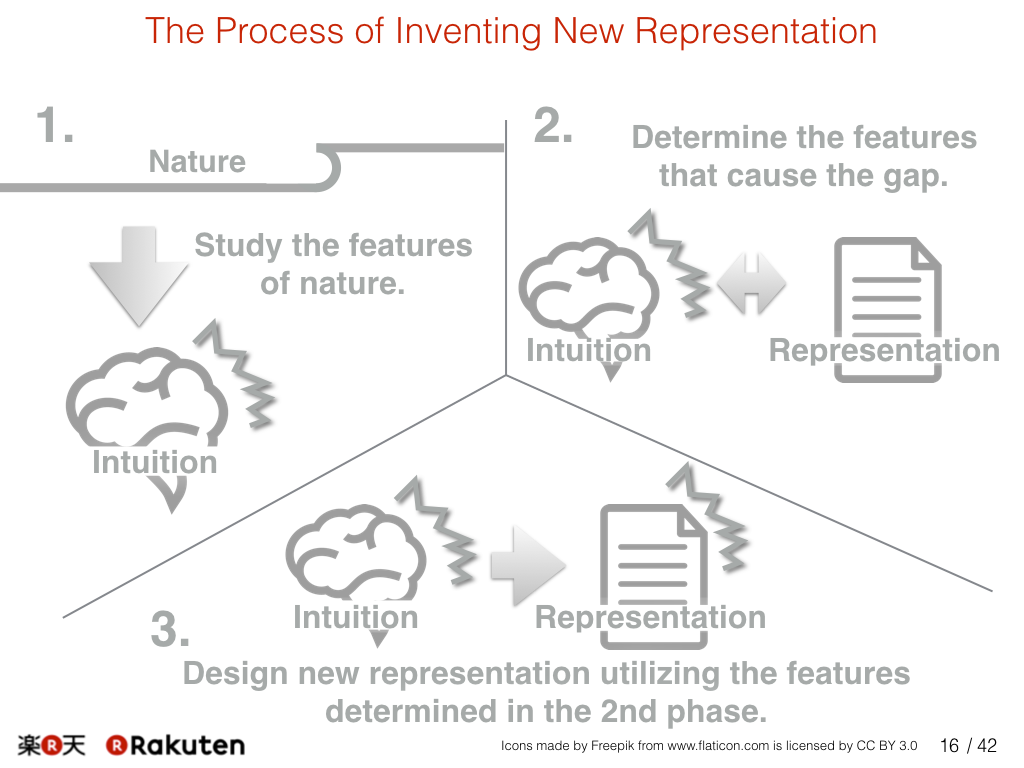
The process of inventing new representation can be divided into three phases.
In the first phase, we study the features of nature and develop our intuition. But then we realize there is a gap created between our intuition and the existing representation. In the second phase, we research in order to find the reason for the gap. In the third phase, we implement the result of the research and create a new representation.
#17
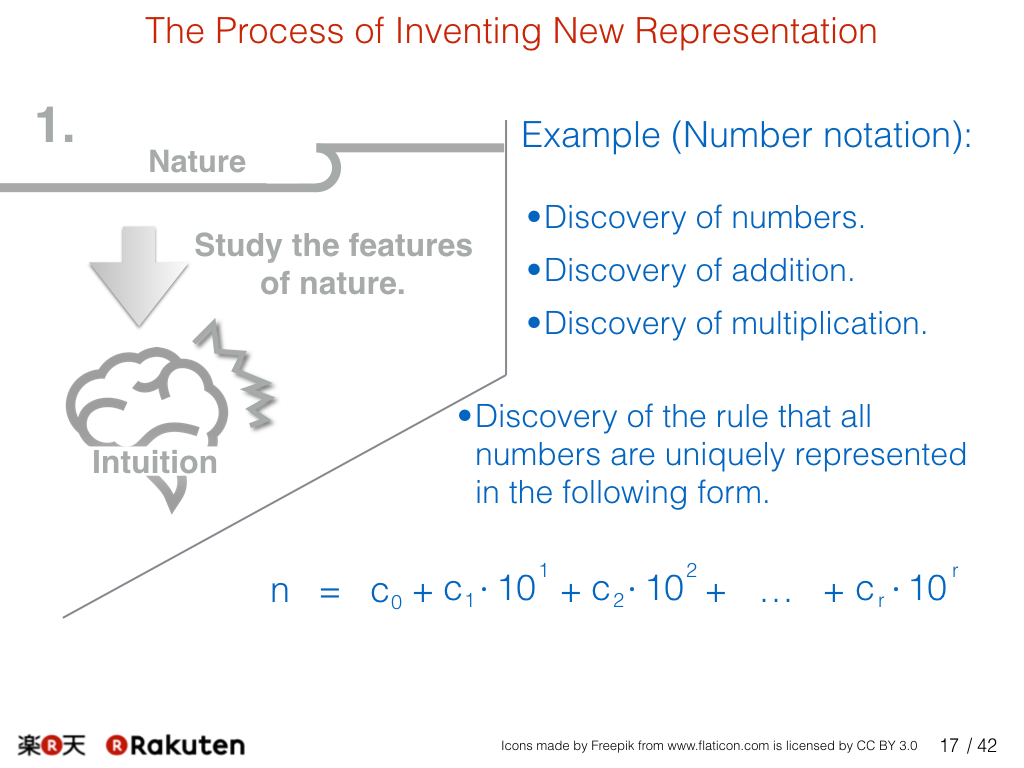
Let’s see the process in more detail with the example from number notation.
In the first phase, we study the features of nature and develop our intuition. In this phase, the notion of numbers, addition, multiplication and various theorems on numbers are discovered. These discoveries include the feature that all numbers are uniquely represented in the form like this.
#18
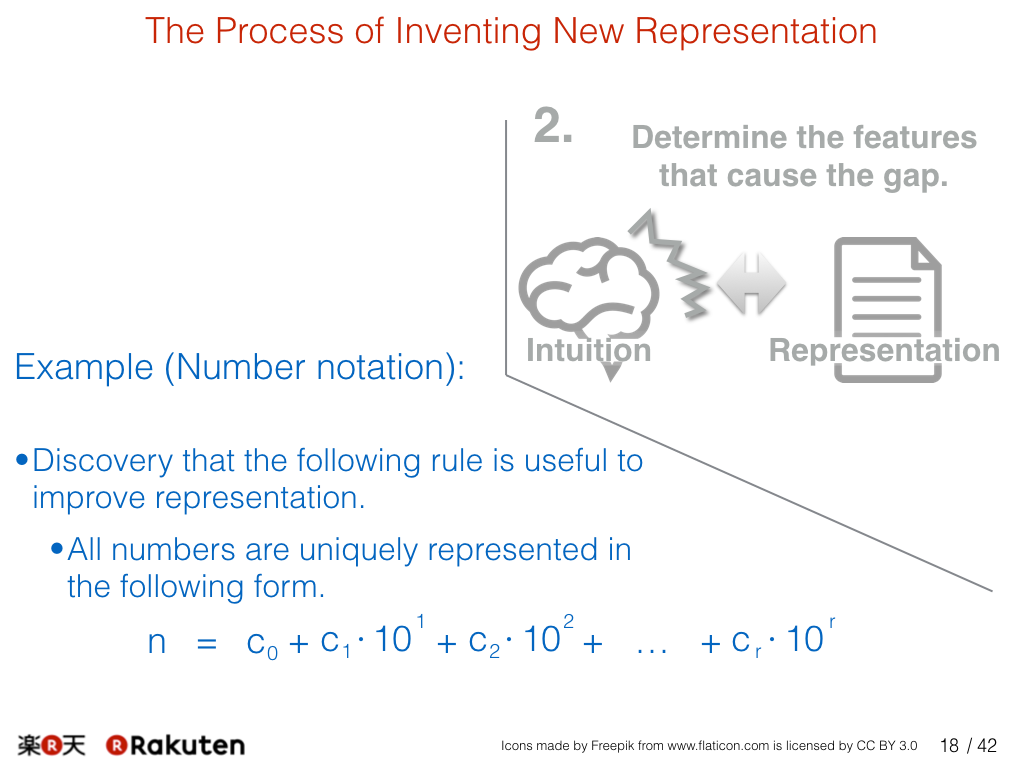
In the second phase, we analyze the gap between our intuition and the existing representation.
In this phase, it is discovered that the feature explained in the previous slide is useful to improve the number notation. There would be many researchers who discovered such feature, but there were only few researchers who can discover it is useful for notation of numbers. It is really difficult to notice the usefulness of this connection before the positional notations is invented.
#19
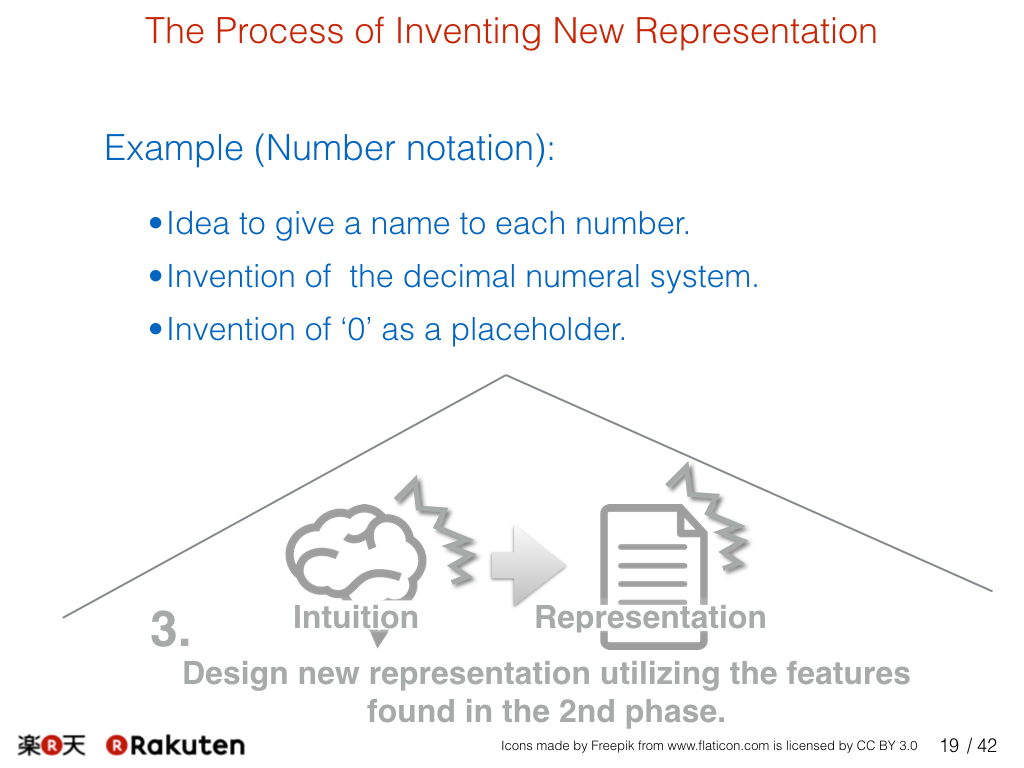
In the third phase, we design new representation utilizing the connection found in the second phase.
In this phase, positional notation was invented and developed utilizing the connection found in the previous phase.
Developing the whole system was really difficult.
#20
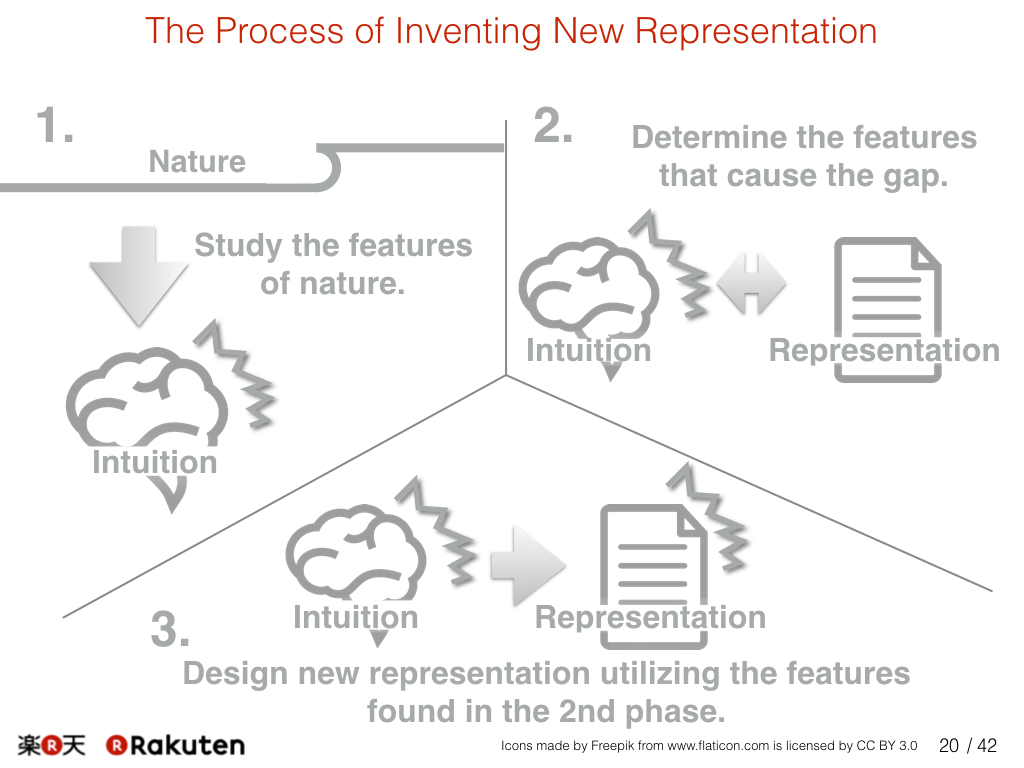
In these three phases, we invent new representation.
#21
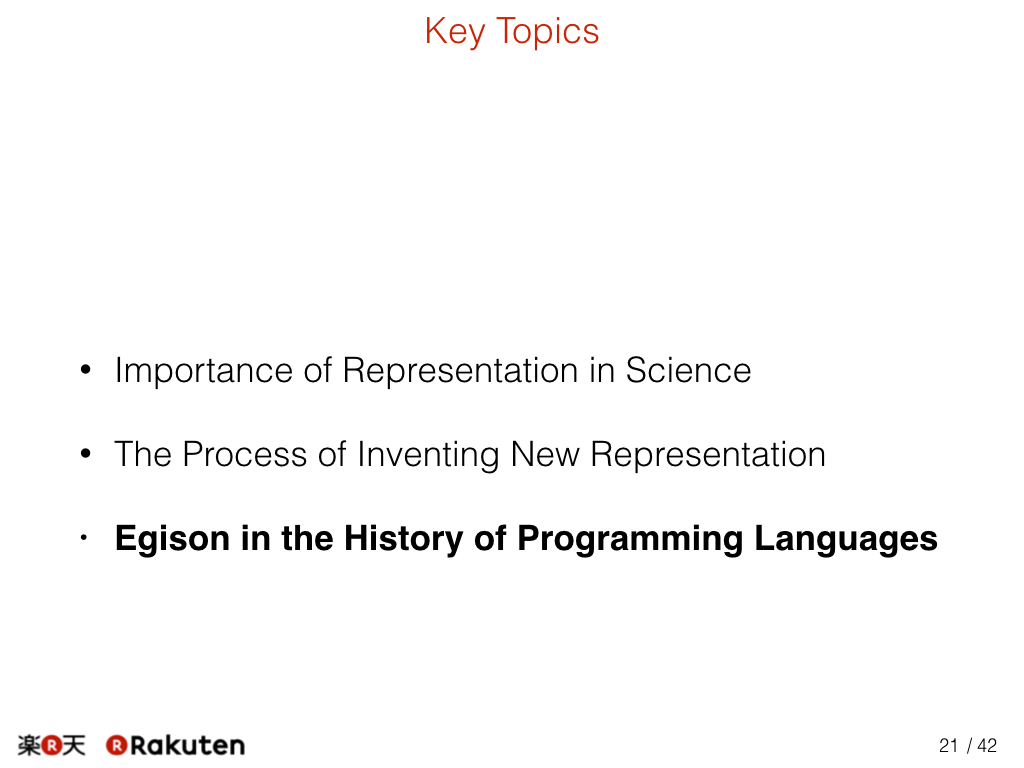
Finally, I’d like to explain about the Egison programming language that I’ve created. I found a new abstraction for new representation in programming languages and implemented it in Egison.
#22
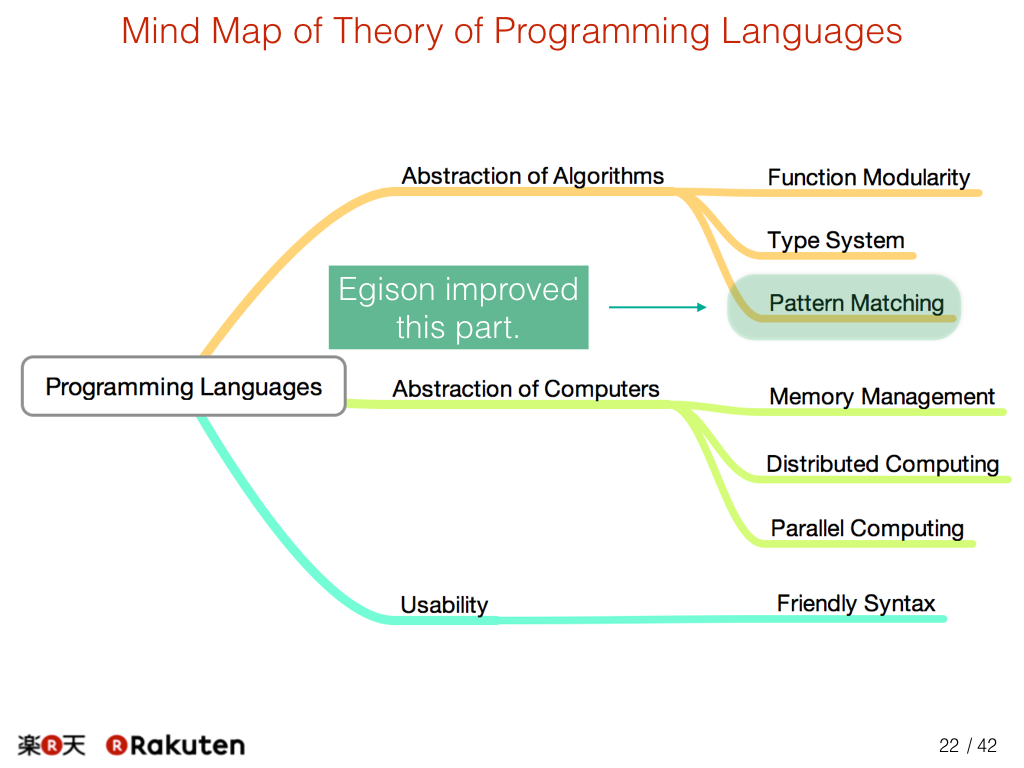
Please take a look at this mind map on the theory of programming languages. There are two kinds of abstraction, the abstraction of algorithms and the abstraction of computers. The abstraction of algorithms contains three topics, functional modularity, type system, and pattern-matching. Egison improved the pattern-matching part.
#23
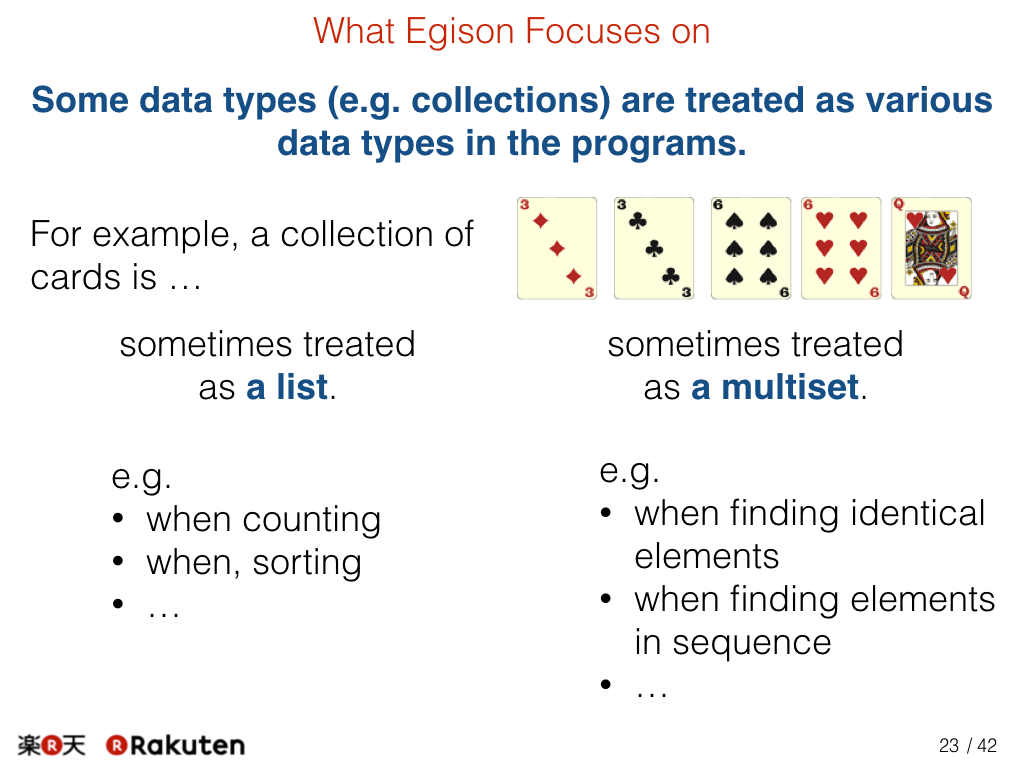
Egison focuses on the fact that some data types such as collections are treated as various data types in the programs.
For example, a collection of cards is sometimes treated as a list of cards and sometimes treated as a multiset of cards. When we treat a collection as a multiset, we ignore the order of the elements. When we count or sort them, we treat them as a list. But when we find identical elements or elements in sequence, it is natural to treat them as a multiset.
#24
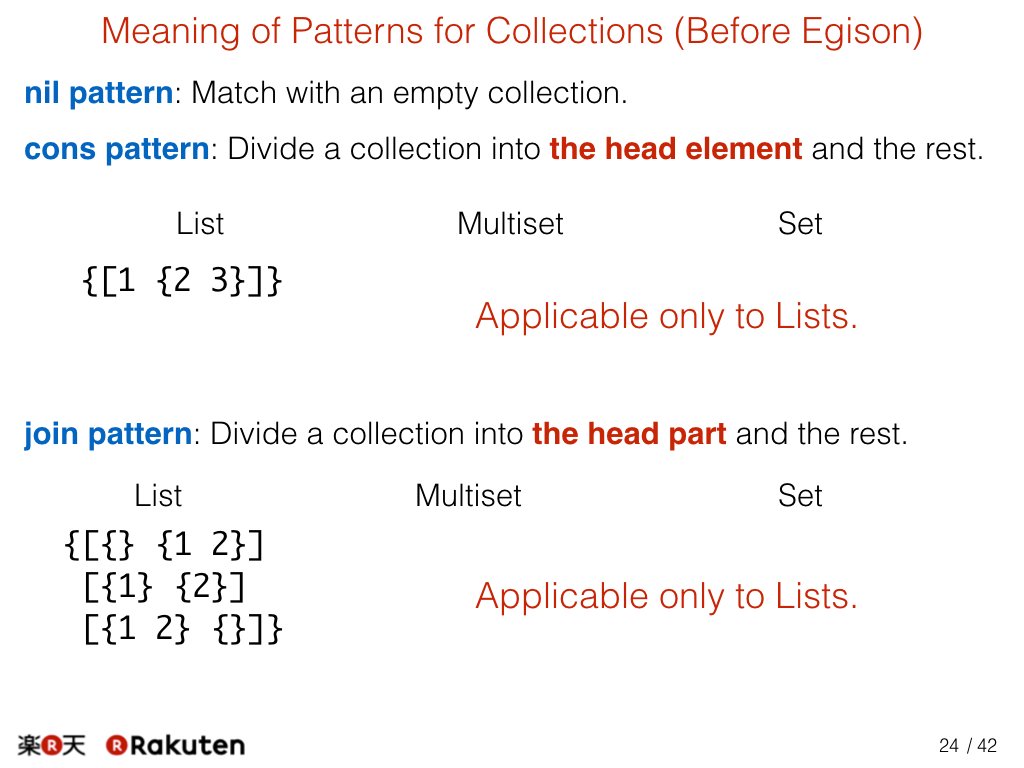
There are mainly three kinds of patterns for collection, nil, cons, and join patterns. We combine them to make various patterns of the collections.
Nil patterns are a pattern that matches with an empty collection. Cons patterns are a pattern that matches with a collection more than one element and divide it into the head element and the rest collection. Join patterns are a pattern that matches with any collection and divide it into two lists, the head part and the rest part. In this definition, cons and join patterns are applicable only to lists. and not applicable to multisets and sets. So we can’t treat multisets and sets directly as lists.
#25
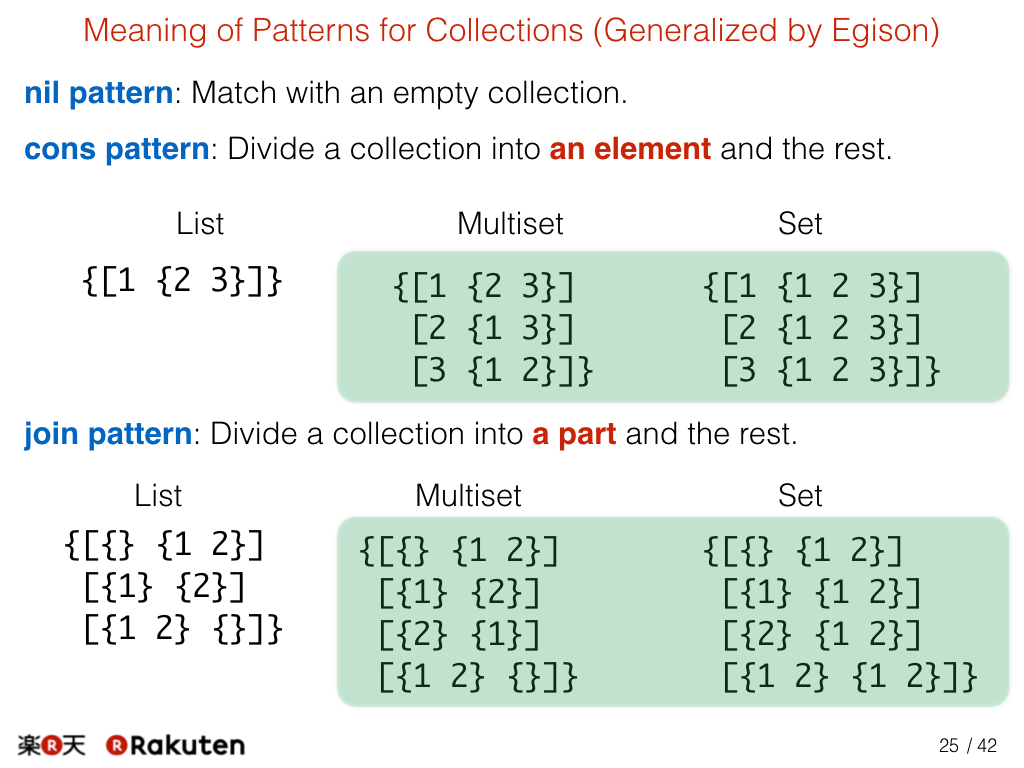
Egison generalized the meaning of these patterns and make them applicable to others. Egison generalized the scope of patterns from head to any. Cons patterns divide a collection into an element and the rest, not the head and the rest. Join patterns divide a collection into just two collections.
When target is a collection 1, 2, 3 and treated as a list, a cons pattern divides it into 1 and 2, 3 as the previous slide. But when target is treated as a multiset, we ignore the order of elements. So, a cons pattern divides it into 1 and 2, 3, 2 and 1,3, 3 and 1,2. When the target is treated as a set, we ignore both of order and duplicates of the elements. So, a cons pattern divides it into 1 and 1,2, 3, 2 and 1,2,3, 3 and 1,2,3.
#26
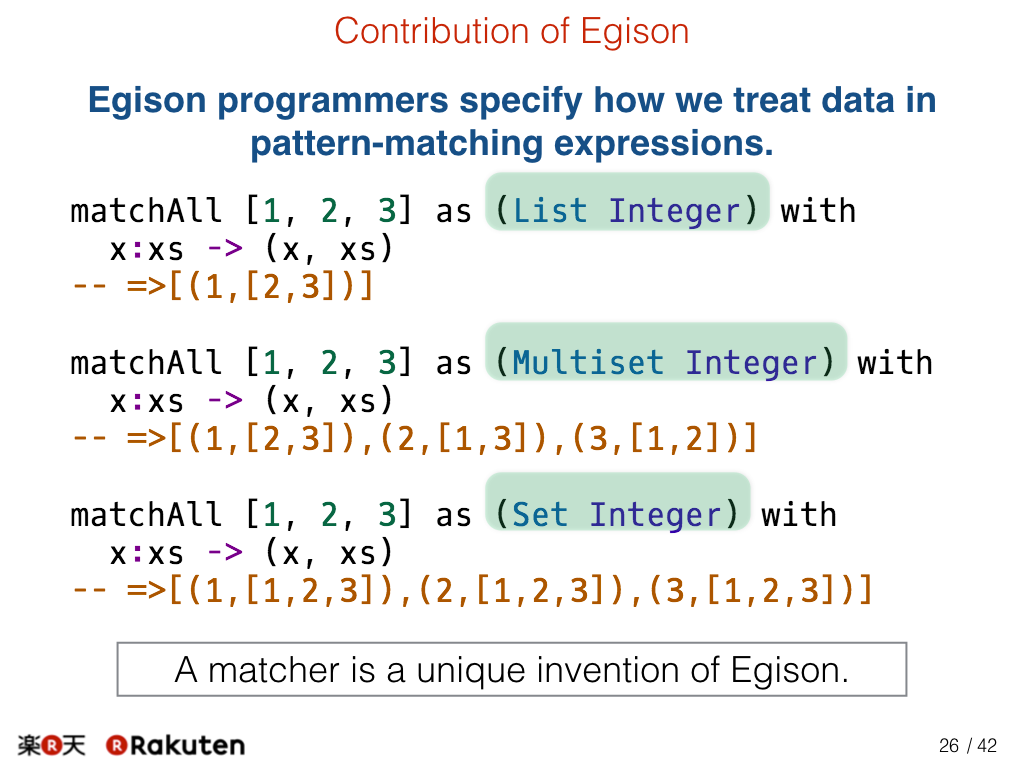
Here are pattern-matching expressions in Egison. Please note that Egison’s pattern-matching expressions take a matcher to specify how the target is pattern-matched. If we set a matcher `List Integer` as the first sample, the target collection `[1,2,3]` is pattern-matched as a list of integers. If we set a matcher `Multiset Integer` as the second sample, the target collection is pattern-matched as a multiset of integers. This matcher is one of the unique inventions of Egison.
#27
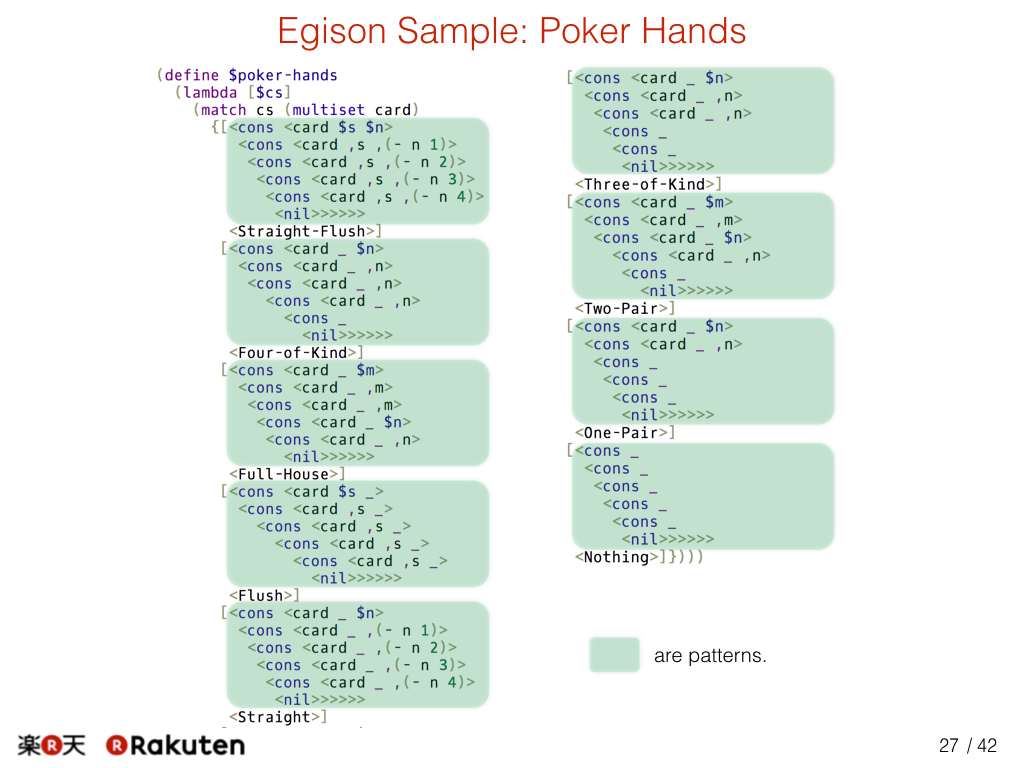
The expressive power of pattern-matching of Egison is so strong that we can express poker-hands pattern-matching in a single expression. All poker-hands are expressed in a single pattern.
#28
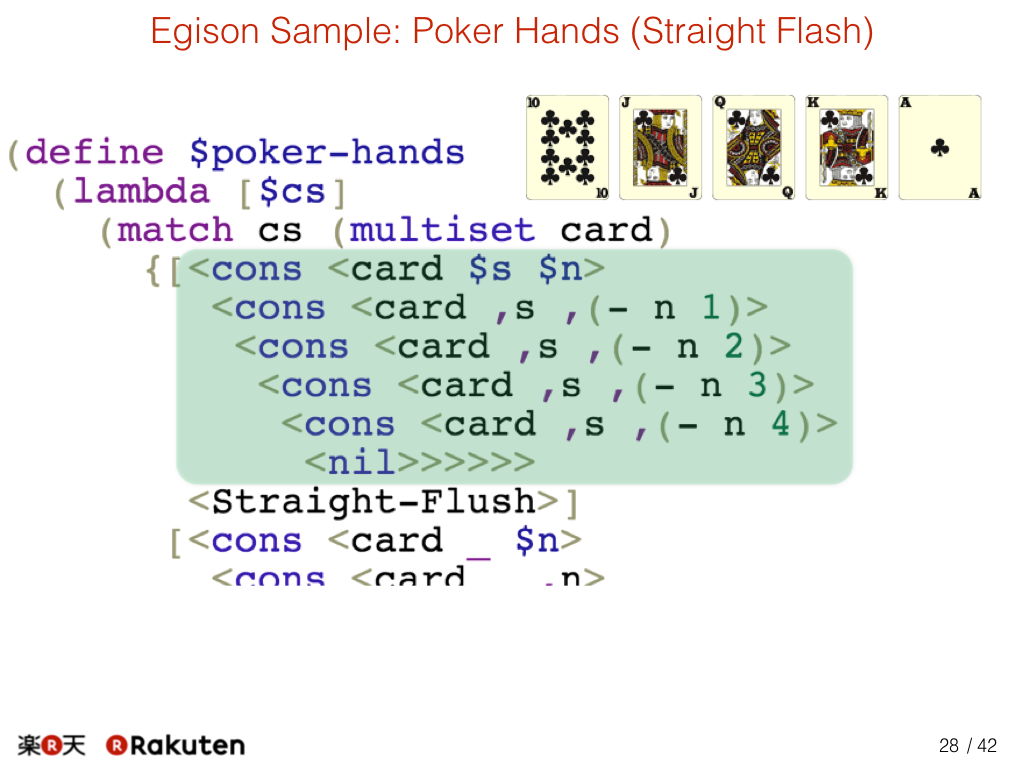
Here is a pattern for straight-flush.
#29
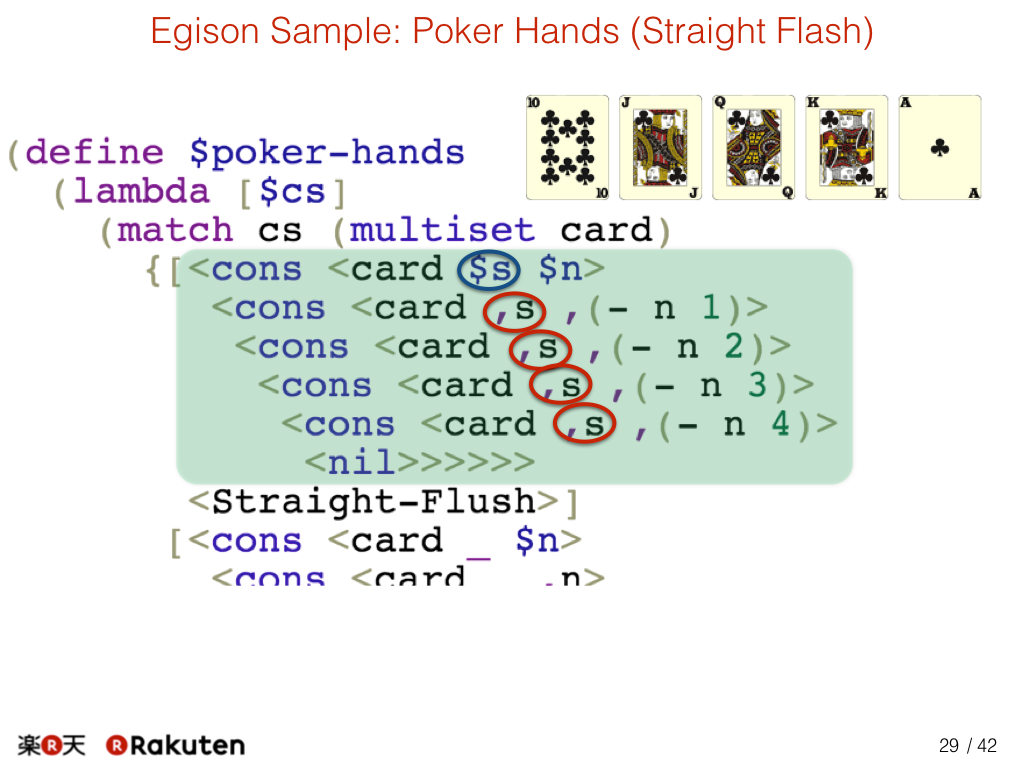
This means all cards have a same suit.
#30
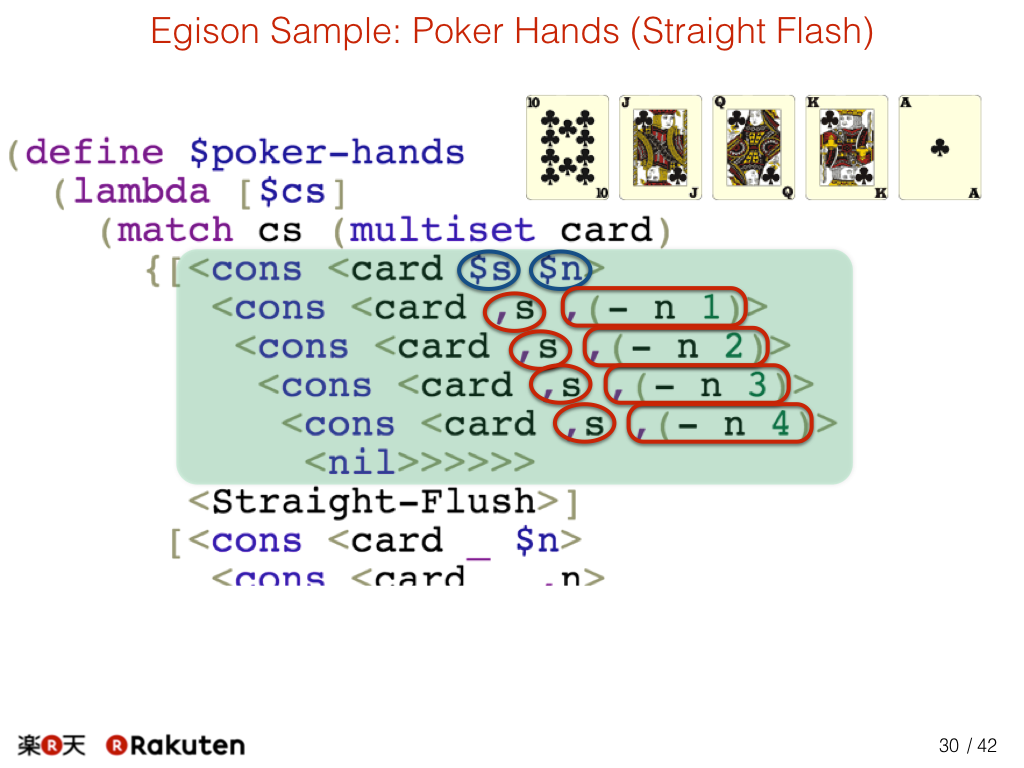
And this means numbers are in sequence.
#31
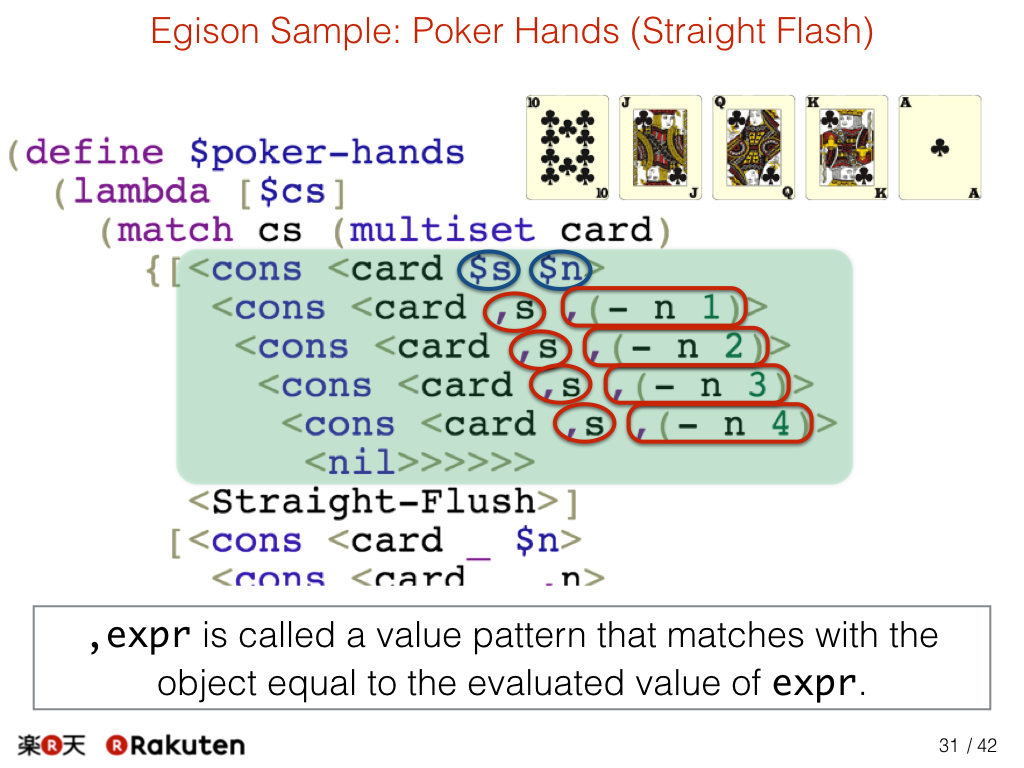
Egison supports a pattern called a non-linear pattern. It allows us to refer the value of the variables whose values are bound within the patterns.
A pattern that begins with a comma is called a value-pattern. A value-pattern matches with the object equal to the evaluated value of the expression after the comma.
#32
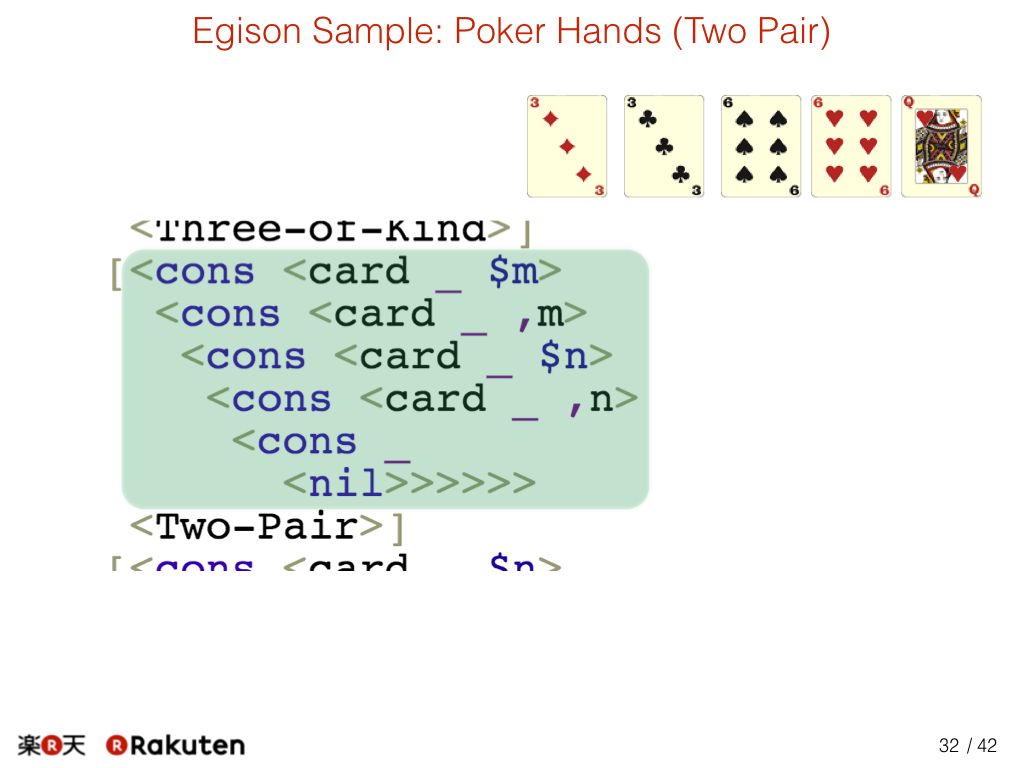
Here is a pattern for two pair.
#33
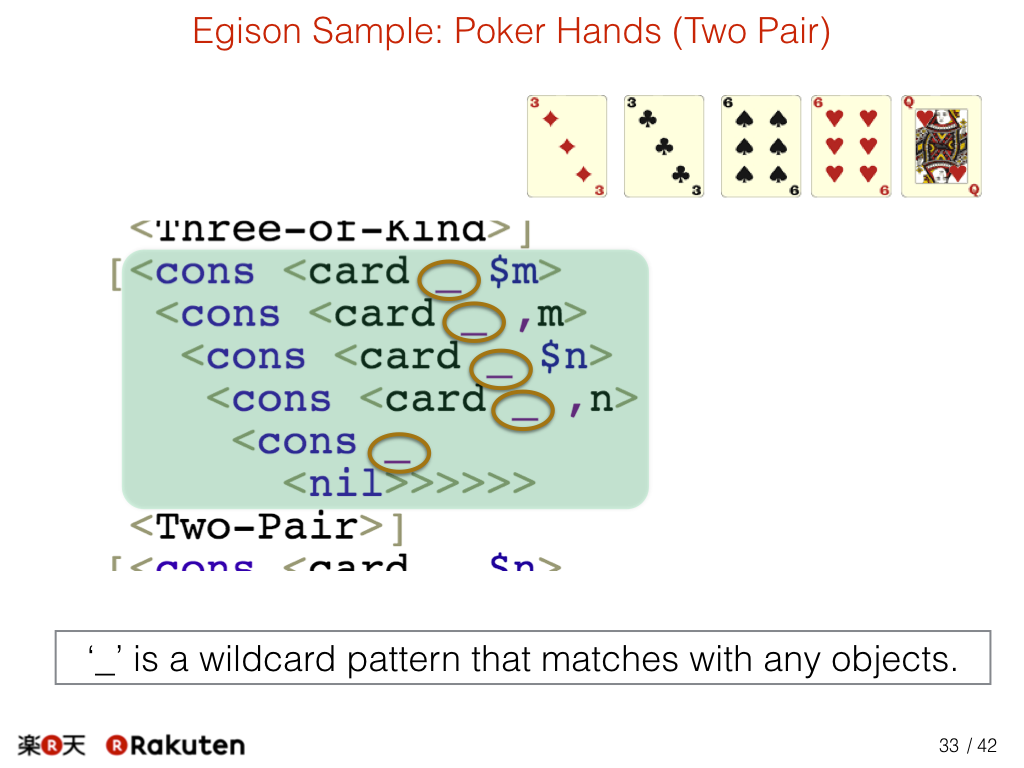
This means the suit of the cards is not important.
#34
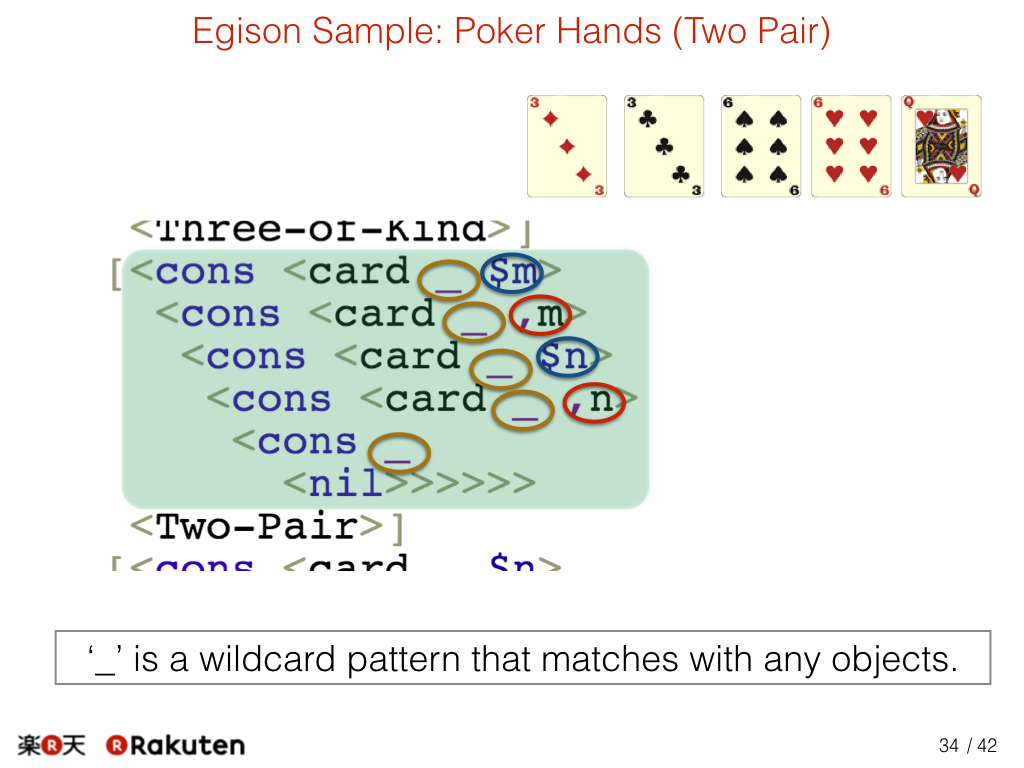
This part means we have two pairs of cards that has same numbers.
#35
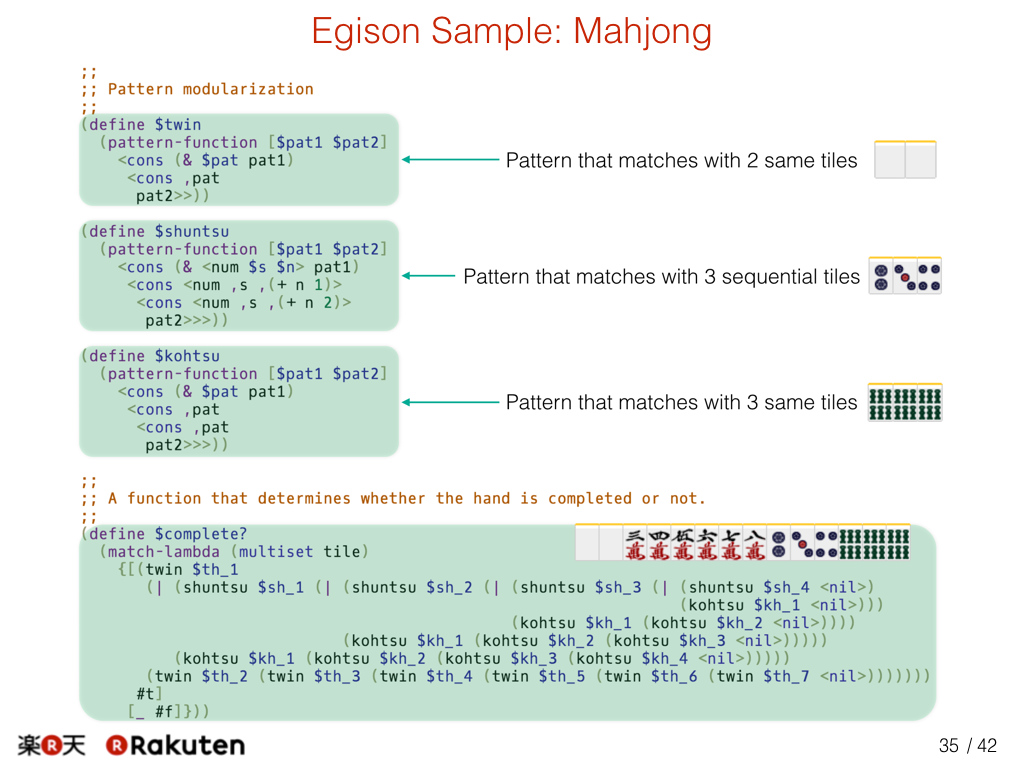
We can create patterns even for mahjong. This program determines whether a mahjong hand is completed or not. We can write that in one slide. In other languages, it will be at least 5 times longer.
#36
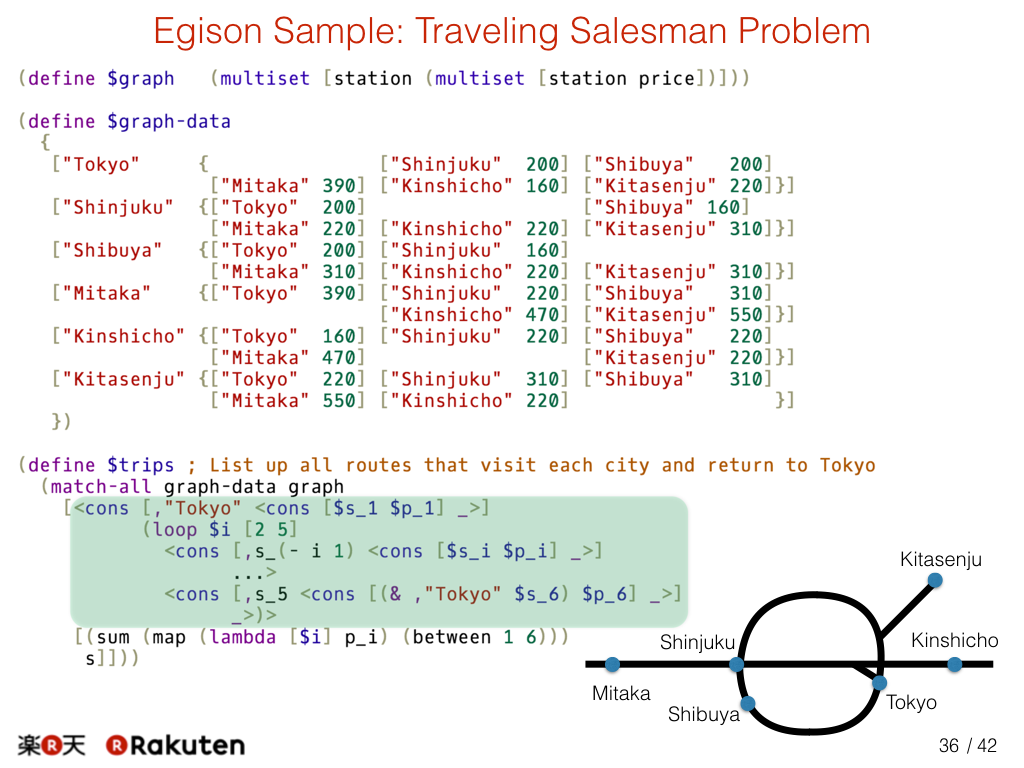
This is a more realistic sample. This program solves the traveling salesman problem. In the Egison system, We can match patterns of various data types. We can create a pattern for graphs as well, like this.
#37
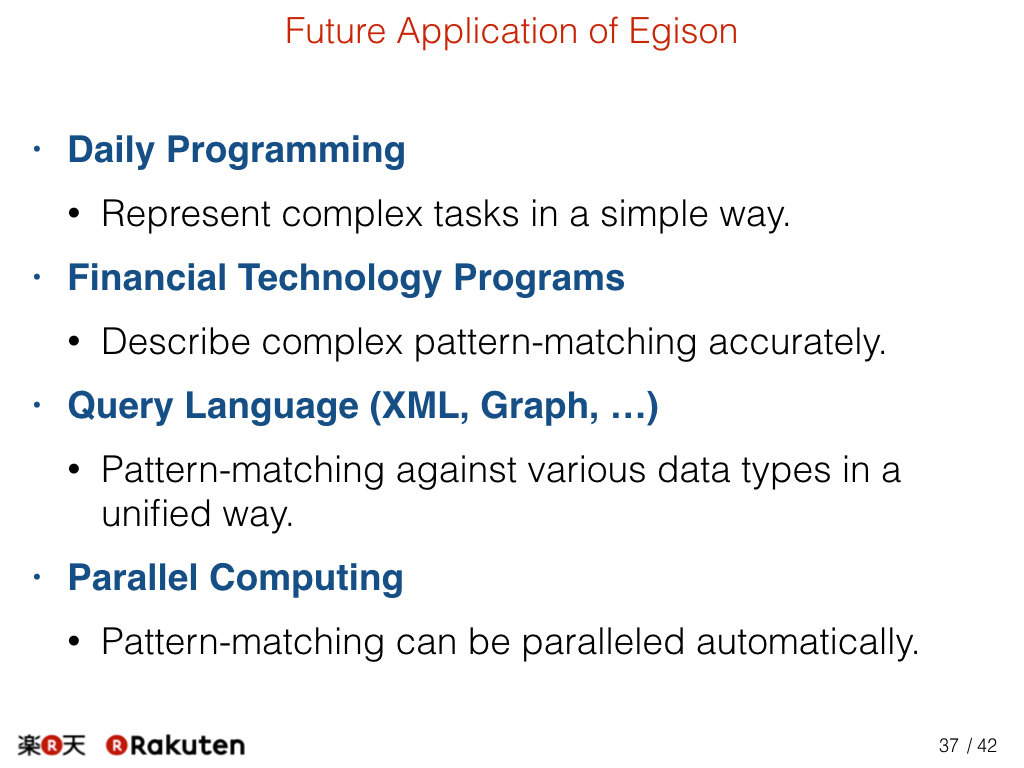
Currently, I am working to solve real problems in Egison. There are several possibilities to do that.
First, I’d like to mention that Egison can represent complex tasks for daily work in a simple way. Second, there is a possibility Egison is useful to financial problems by describing complex patterns accurately for chart analysis. Third, Egison provides a way to pattern-match for various data types in a unified way for data query. Fourth, pattern-matching in Egison can be paralleled automatically. So, we can write parallel programs very easily in Egison.
My next year’s goal is to utilize Egison in one of these fields in Rakuten.
#38
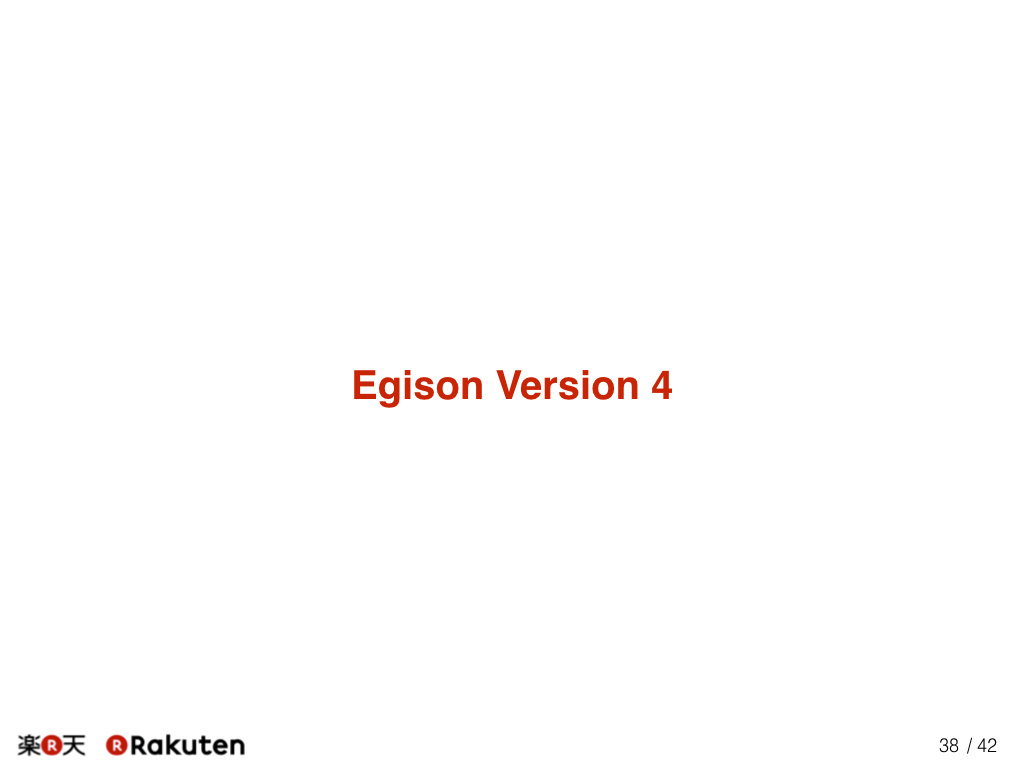
Finally, let me talk about the next version of Egison, Egison version 4.
#39
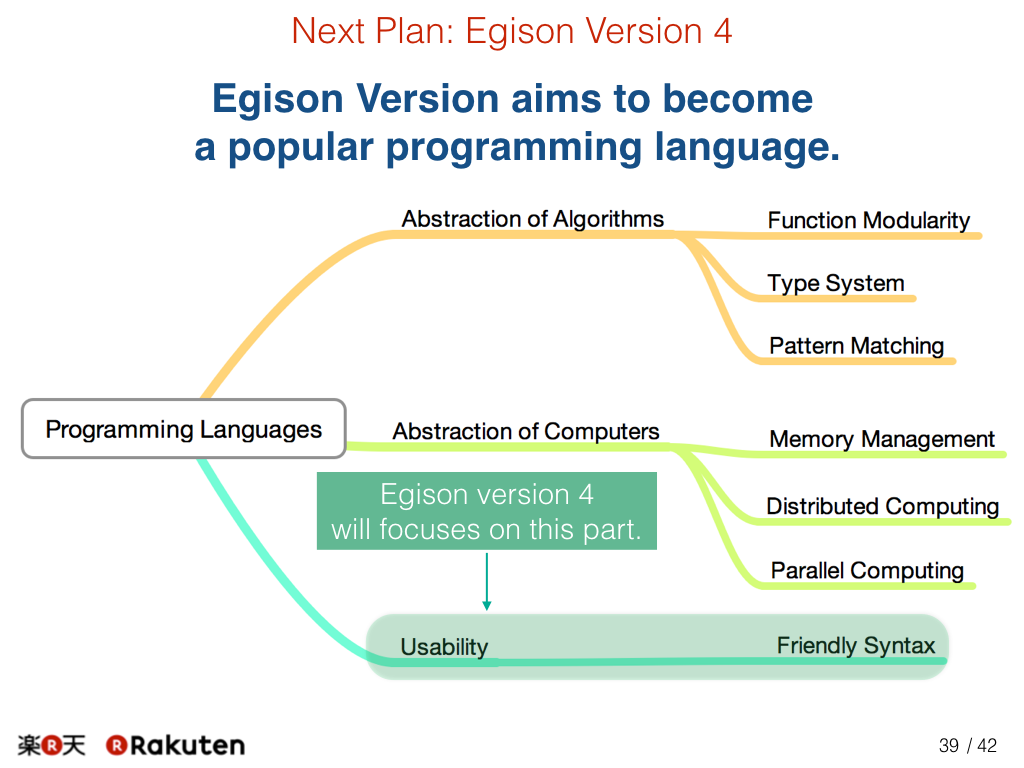
Egison Version 4 will aim to become a popular programming language. For that, I will focus to improve usability of Egison and seriously proceed research on friendly syntax.
#40
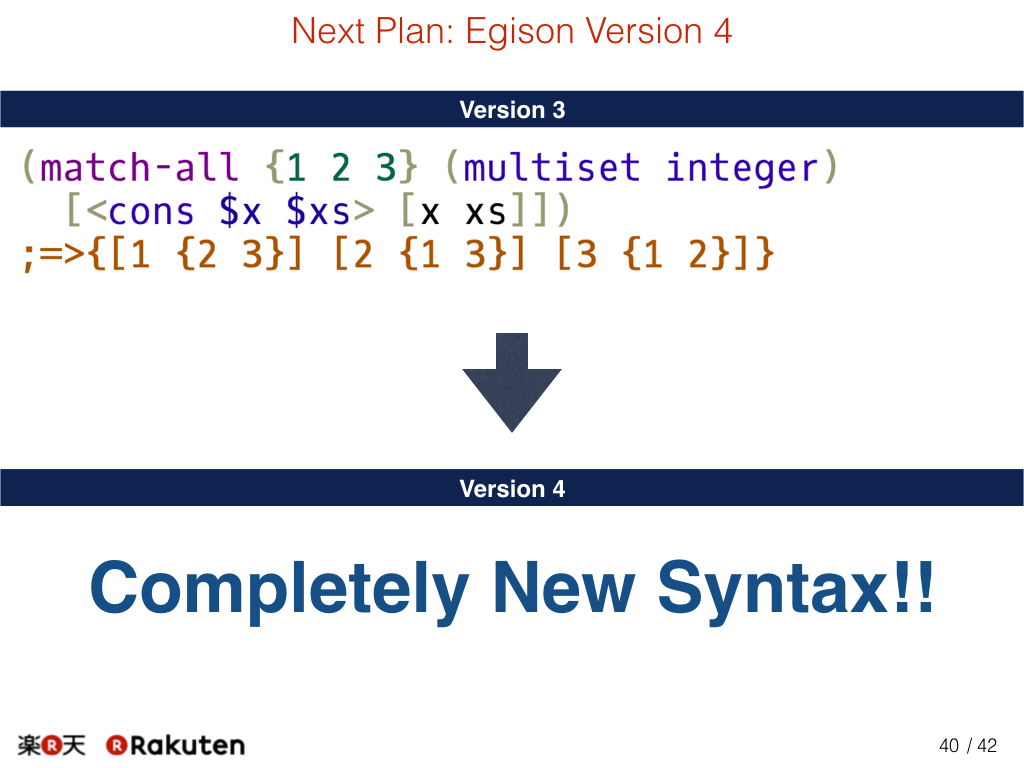
We will provide completely new syntax in the next version. We will remove at least this, … a lot of parenthesis. I hope you'll enjoy it.
#41
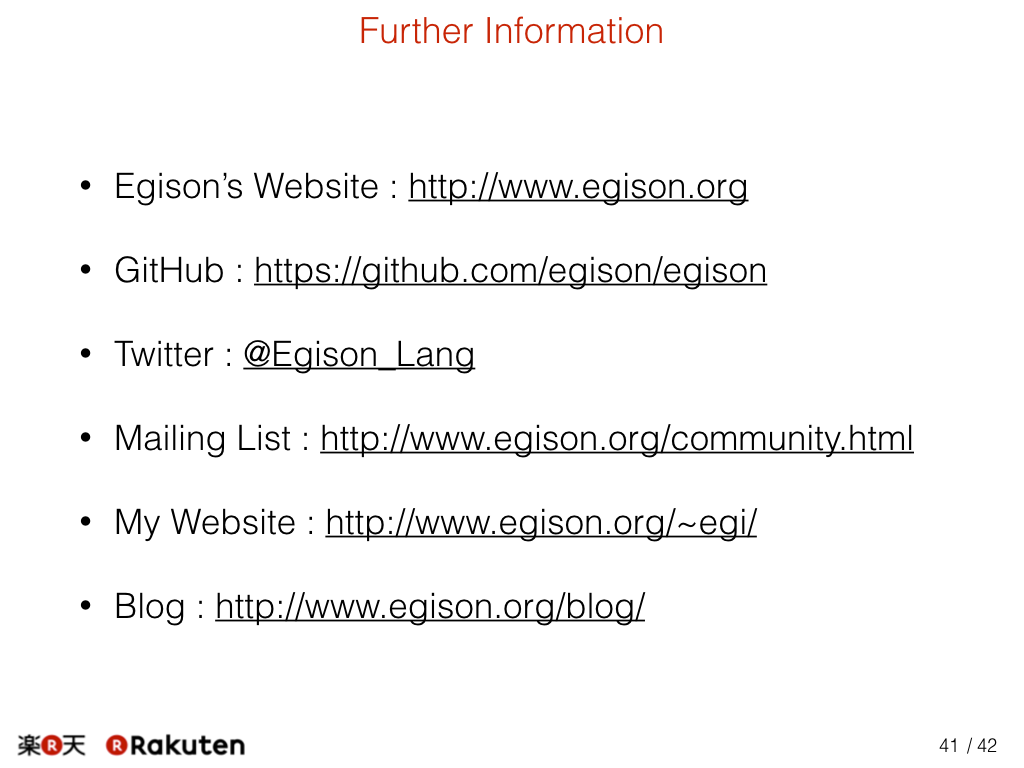
Here are links for further information on Egison. I have already uploaded my presentation on my blog. Please check it.
#42

Rakuten Institute of Technology is hiring researchers, data scientists, coordinators, and part-time research assistants. Please contact us if you are interested in these posts. Thank you so much for your attention.
Article List
- APLAS 2018 Presentation: Non-linear Pattern Matching with Backtracking for Non-free Data Types [2018/12/03]
- Egison Presentation for Rakuten Technology Conference 2017 [2017/10/31]
- Egison Presentation for the Scheme and Functional Programming Workshop 2017 [2017/09/16]
- Egison Presentation for Rakuten Technology Conference 2015 [2015/11/21]
- Solve Project Euler in Egison [2015/07/02]
- Software Japan Award Ceremony [2015/02/12]
- Egison Presentation at RubyKaigi 2014 [2014/09/21]
- The 3 Exciting Moments Developing Egison [2014/08/26]
- Evolution of Egison Website in This 8 Months [2014/08/21]
- The Ruby Gem for Ultra Super Pattern Matching [2014/06/16]
- The 6 Programming Languages Interesting to Try [2014/05/21]
- Evolution of Programming Languages [2014/05/12]
- My Aim - Thoght on Artificial Intelligence [2014/05/09]